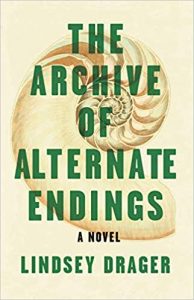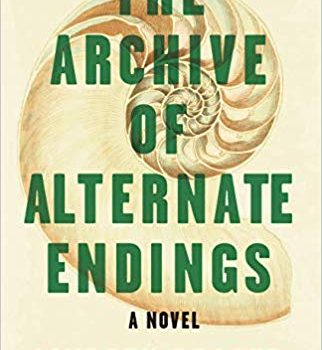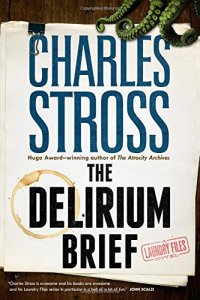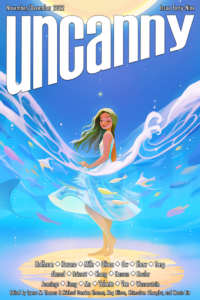Ian Mond Reviews The Archive of Alternate Endings by Lindsey Drager
 The Archive of Alternate Endings, Lindsey Drager (Dzanc 978-1945814822, $16.95, 168pp, tp) May 2019.
The Archive of Alternate Endings, Lindsey Drager (Dzanc 978-1945814822, $16.95, 168pp, tp) May 2019.
Above the ten chapter headings that make up Lindsey Drager’s remarkable short novel The Archive of Alternate Endings are a range of years beginning with 1378 and ending with 2365. Those mathematically inclined will note a 75- to 79-year gap between each year, and those who know their celestial bodies will figure out that this corresponds with the recorded and expected return of Halley’s Comet to Earth. The 11 stories that weave their way through the novel are associated with a year when 1P/Halley has or will grace the night sky.
If the orbital path of Halley’s Comet provides The Archive of Alternate Endings its structure, then Drager’s second influence, the tale of Hansel and Gretel, embodies the novel’s essence. For example, the opening chapter, “Of Breadcrumbs and Constellations”, is set in and around 1835 and 1986. The 1835 section, unsurprisingly, concerns the Brothers Grimm, Jakob and Wilhelm, and their gathering and editing of “malleable myths” that would form Grimm’s Fairy Tales, the first edition of which included “Hansel and Gretel”. The account, though, deals less with how the brothers moulded and reshaped that famous tale and rather focuses on Jakob’s sexuality, with the strong suggestion that he was gay (apparently an open question in academia). When we shift across to 1986, Drager deals head-on with the AIDS crisis. A young man – a writer – who happens to be a descendant of Wilhelm Grimm, catches the eye of another man – a computer programmer – at the theatre. They spend the night together, and the next morning, when the writer asks the computer programmer whether they will meet again, the programmer takes down a copy of The Illustrated Hansel and Gretel that he spies on the writer’s bookshelf and tells him to “follow the breadcrumbs.” It’s romantic and sweet and tragically undercut by the fact that both of them will be dead from complications arising from AIDS within the year.
As we move forward and backward in time, to a future where the environment is in collapse, taking what’s left of humanity with it (2136), to a past where a young girl protects her brother, both of them abandoned in the woods (1378), multiple themes begin to emerge. One of those concerns the enduring power of storytelling and how our desire to communicate through narrative – both fact and fiction – led to the development of technologies to facilitate this, such as Johannes Gutenberg and his printing press. Drager takes us to 1456, where Gutenberg’s twin sister (Hansel and Gretel are sometimes portrayed as twins), decides to reveal to her brother that their father sexually abused her. In a moment of heart-rending prescience, Johannes reflects that the printing press…
… is for her, and all those who need a way to tell their stories. It is for every sister who once had a story that went unbelieved.
Skip nearly 800 years and that human need to communicate and share a story has reached a technological and almost transcendent endpoint as two marvels of our ingenuity, probes (also twins) traversing the reaches of space, disseminate, in binary, the Brother’s Grimm version of Hansel and Gretel to the “infinite beyond.”
A second thread that becomes apparent is how Drager reframes “Hansel and Gretel”, subtly and overtly, as a tale about those who have been marginalised throughout history. There’s Edmund Halley’s niece, bright and inquisitive, (sometimes Gretel is portrayed as the older of the two siblings) who fears for her future because she has been cursed with intelligence at a time when female empowerment is another word for witchcraft. And then there’s the woman who sketched the drawings for The Illustrated Hansel and Gretel (the same edition owned by the writer), committed by her father to an asylum (the woods) in 1910 because he loathes her bohemian “lifestyle,” particularly her love of other women. Most astonishing of all, though, is how the witch is recontextualised as a woman selflessly caring for gay men infected with AIDS. It’s the parents, who have heartlessly and cruelly disowned (abandoned) their dying boys, that have labelled her a witch.
The Archive of Alternate Endings is an incredible novel. A book small in size but loaded with imagery – labyrinths and nautiluses – and themes beyond those I’ve touched on above. All of it is in service to a single, powerful message that folk tales about children abandoned in the woods, about houses built of cakes and lollies, about horrible parents and hungry witches, endure not to teach us a lesson but “for one purpose only, and that purpose is to say this: “Being human is difficult. Here is some evidence.”
Ian Mond loves to talk about books. For eight years he co-hosted a book podcast, The Writer and the Critic, with Kirstyn McDermott. Recently he has revived his blog, The Hysterical Hamster, and is again posting mostly vulgar reviews on an eclectic range of literary and genre novels. You can also follow Ian on Twitter (@Mondyboy) or contact him at mondyboy74@gmail.com.
This review and more like it in the June 2019 issue of Locus.
 While you are here, please take a moment to support Locus with a one-time or recurring donation. We rely on reader donations to keep the magazine and site going, and would like to keep the site paywall free, but WE NEED YOUR FINANCIAL SUPPORT to continue quality coverage of the science fiction and fantasy field.
While you are here, please take a moment to support Locus with a one-time or recurring donation. We rely on reader donations to keep the magazine and site going, and would like to keep the site paywall free, but WE NEED YOUR FINANCIAL SUPPORT to continue quality coverage of the science fiction and fantasy field.








